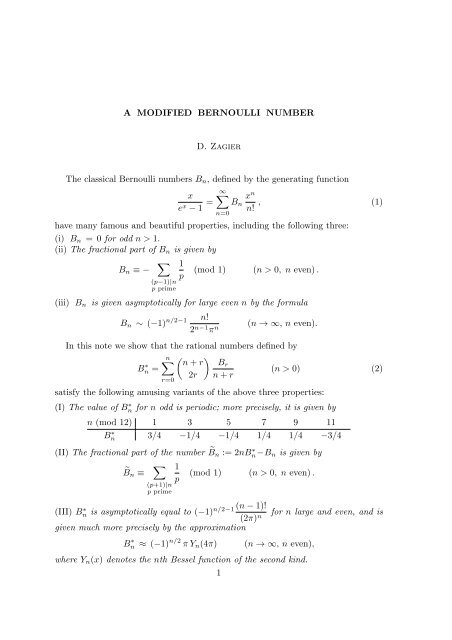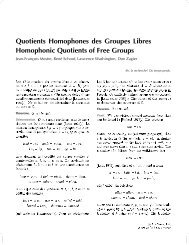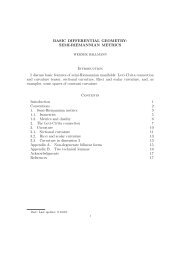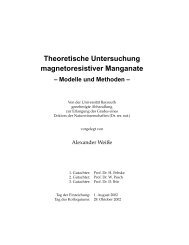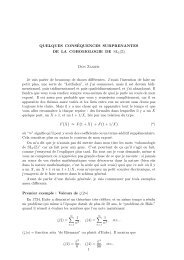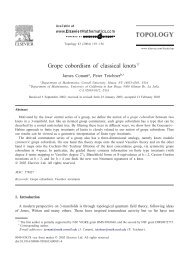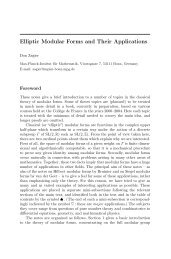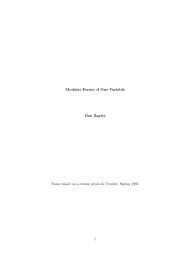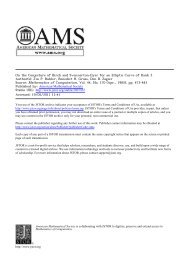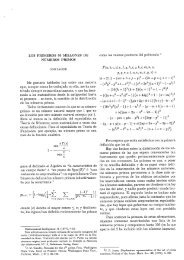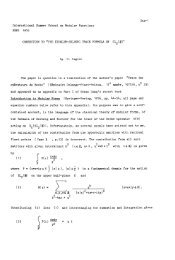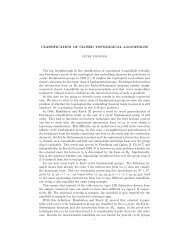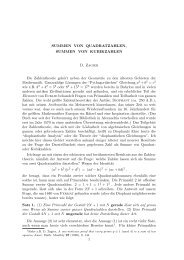A MODIFIED BERNOULLI NUMBER D. Zagier The classical ... - Up To
A MODIFIED BERNOULLI NUMBER D. Zagier The classical ... - Up To
A MODIFIED BERNOULLI NUMBER D. Zagier The classical ... - Up To
You also want an ePaper? Increase the reach of your titles
YUMPU automatically turns print PDFs into web optimized ePapers that Google loves.
A <strong>MODIFIED</strong> <strong>BERNOULLI</strong> <strong>NUMBER</strong>D. <strong>Zagier</strong><strong>The</strong> <strong>classical</strong> Bernoulli numbers B n , defined by the generating functionx∞e x −1 = ∑n=0B nx nn! , (1)have many famous and beautiful properties, including the following three:(i) B n = 0 for odd n > 1.(ii) <strong>The</strong> fractional part of B n is given byB n ≡ − ∑(mod 1) (n > 0, n even).(p−1)|np prime1p(iii) B n is given asymptotically for large even n by the formulaB n ∼ (−1) n/2−1 n!2 n−1 π n (n → ∞, n even).In this note we show that the rational numbers defined byn∑( ) n+rBn ∗ Br=(n > 0) (2)2r n+rr=0satisfy the following amusing variants of the above three properties:(I) <strong>The</strong> value of B ∗ n for n odd is periodic; more precisely, it is given byn (mod 12) 1 3 5 7 9 11Bn ∗ 3/4 −1/4 −1/4 1/4 1/4 −3/4(II) <strong>The</strong> fractional part of the number ˜B n := 2nBn−B ∗ n is given by˜B n ≡ ∑ 1(mod 1) (n > 0, n even).p(p+1)|np prime(III) B ∗ n is asymptotically equal to (−1) n/2−1(n−1)!(2π) n for n large and even, and isgiven much more precisely by the approximationB ∗ n ≈ (−1) n/2 πY n (4π)(n → ∞, n even),where Y n (x) denotes the nth Bessel function of the second kind.1
<strong>The</strong> proofs of (I)–(III) will be given in the next three sections, after which we willgive the statement and proof of a fourth property, an exact formula for B ∗ n refiningthe asymptotic formula (III). <strong>The</strong> proofs, especially those of (I) and (II), are quitefun and the reader is invited to try to find them him/herself before proceeding.We end the introduction with a small table of the numbers B ∗ n and ˜B n .n 2 4 6 8 10 12 14 16 18 20B ∗ n124 −27 80 − 291260˜B n 0 − 8 3− 3104511120 − 65264 − 65711201213621−5 − 4249330571312 −181613 3808065113− 305621236635131220940 −10188203 83600109269170− 24770057Proof of (I). Instead of using the familiar generating function (1), we representthe Bernoulli numbers by the generating functionF(x) =∞∑r=1B rr xr ∈ Q[[x]].This formal power series does not converge anywhere, but occurs in the asymptoticformulaΓ ′ (X)∼ logX − 1 Γ(X) X − F( 1 )(X → ∞)Xfor the logarithmic derivative of the gamma function, and the functional equationΓ(X +1) = XΓ(X) of the gamma function implies the functional equationF ( x )= F(x)+x+log(1−x) ∈ Q[[x]] (3)1−xof the power series F. An elementary proof of (3), or of the equivalent but simplerfunctional equation G ( x )= G(x) − x 2 for the simpler power series G(x) =∑ ∞1−xr=0 B rx r+1 = x + x 2 F ′ (x), can be obtained by noting that either one of thesefunctional equations is equivalent to the standard recursion formulan−1∑( nB k = 0 (n > 1) (4)k)k=0for the Bernoulli numbers, which is in turn an easy restatement of the definition (1).Now introduce a new power series F λ (x), depending on a parameter λ, byF λ (x) = F ( x )−log(1−λx+x 21−λx+x 2 ) ∈ Q[[x]].For λ = 2 this specializes toF 2 (x) =∞∑r=1B rrx r∞(1−x) 2r −2log(1−x) = 2 ∑2n=1B ∗ nx n . (5)
Ontheotherhand, thefunctionalequation(3)togetherwiththesymmetrypropertyF(−x) = F(x)+x, which is a restatement of (i), give the functional equationsF λ+1 (x) = F λ (x)+for the power series F λ . We deducex1−λx+x 2 = F −λ(−x)F 2 (x)−F 2 (−x) = ( F 2 (x)−F 1 (x) ) + ( F 1 (x)−F 0 (x) ) + ( F 0 (x)−F −1 (x) )=x1−x+x 2 + x1+x 2 + x1+x+x 2 = 3x−x3 −x 5 +x 7 +x 9 −3x 111−x 12 .Statement (I) follows.Proof of (II). Rather surprisingly, this property is a consequence of the analogousproperty (ii) for the usual Bernoulli numbers, the divisibility by p−1 being metamorphosedinto the divisibility by p+1 by the magic of generating functions. Webegin by rewriting the definition of ˜B n as˜B n =n−1∑r=0(n+r)+(n−r)n+r( n+r2r)B r = β n +β n−1 −B n , (6)whereβ n =n∑( ) n+rB r (n ≥ 0).2rr=0Fix a prime p. We want to show that p˜B n is p-integral for all n and is congruentto 1 mod p if p + 1 divides n and to 0 otherwise. We suppose that p > 2. (<strong>The</strong>case p = 2 is similar but easier.) By (ii) we know that pB r is p-integral and iscongruent to −1 mod p if p−1 divides r > 0 and to 0 otherwise. Equation (6) thenimmediately gives the p-integrality of p˜B n and the congruence{ 1 if (p−1)|np˜B n ≡ −γ n −γ n−1 +0 otherwise(7)(here and from now on all congruences are modulo p), whereγ n =∑r>0, (p−1)|r( n+rAs usual, we use generating functions. From the definition of γ n we have∞∑γ n x n =n=0∑r>0, (p−1)|rx r(1−x) 2r+1 =32r).x p−1(1−x) 2p−1 −x p−1 (1−x) .
Hence (7) gives∑∞∑p˜B n x n ≡ −(1+x)n>0≡ −(1+x)n=0<strong>The</strong> expression on the right simplifies toγ n x n + xp−11−x p−1x p−1 (1−x)(1−x p ) 2 −x p−1 (1−x) 2 + xp−11−x p−1 .x p+11−xp+1, completing the proof.Proof of (III). As in the proofs of (I) and (II), we deduce property (III) from its<strong>classical</strong> Bernoulli analogue. Suppose n is even and large. <strong>The</strong>n for r = n−k withk fixed (and even) we have( 2n+r2r)Br2n+r = (−1)n/2−1 (n−1)!(2π) n( (−1) k/2 (4π) kk!+O ( 1) ) ,nand since ∑ (−1)k/2 (4π) k= cos(4π) = 1 this gives the asymptotic formula in (III).k!<strong>The</strong> same argument in conjunction with the binomial coefficient identity( ) 2n+r 12r 2n+r = 1 ∑ (−1) h 2 k−2h (n−h−1)!(r = n−k)2r! h!(k −2h)!0≤h≤k/2(which holds because both sides express the coefficient of x k in (1−2x+x 2 ) −r /2r)lets us replace the asymptotic formula for B ∗ n by the full asymptotic expansion(−1) n/2−1 B ∗ n ∼ ∑ h≥0(n−h−1)!h!(2π) −n+2h .Consulting standard reference works, we discover that the expression on the rightis also the asymptotic development of −πY n (4π), since Y n is defined byn−1∑ (n−h−1)!∞∑−πY n (2x) = x −n+2h + (c h +c n+h −2logx) (−1)h x 2h+nh!h!(n+h)!h=0with c h = 1+ 1 2 +···+ 1 h−γ = O(logh). (Cf. [1], 7.2(32).) This proves the secondassertion in (III), though without any estimate of the error.Here are a few numerical values to illustrate the accuracy of the two approximationsfor Bn ∗ in (III) :n 20 30 50(n−1)!(2π) −n 13.228 10026347.89 0.75008667460769577×10 23−πY n (4π) 122.319 40532569.11 1.69052138468088825×10 23(−1) n/2−1 B ∗ n 121.868 40532573.81 1.69052138468090709×10 23<strong>The</strong> poorness of the approximations in the first row is explained by the aboveasymptotic expansion, which shows that the ratio of |B ∗ n| to (n − 1)!(2π) −n is1+Cn −1 +O(n −2 ) with C = 4π 2 ≈ 40.4h=0
An exact formula. In the case of the usual Bernoulli numbers, the rough asymptoticformula (iii) can be replaced by the exact formula(B n = (−1)n/2−1 n!2 n−1 π n 1+ 12 n + 1 +···)3 n (n > 0, n even) (8)due to Euler. It is reasonable to look for a corresponding exact formula for Bn.∗We start with numerical data. From the table above we have B50 ∗ +πY 50 (4π) ≈1,884 × 10 9 , the exact value being 1884415006.56.... Guessing that this differencemight be related to the value −πY 50 (8π), we compute this latter number,which turns out to be 1884414704.76 ... , suggesting that we are on the right track.Going one step further, we find that the difference B50 ∗ + πY 50 (4π) + πY 50 (8π)equals 301.79..., rather close to the value −πY 50 (12π) = 300.89.... This suggeststhat Bn ∗ might be very well approximated by, or even equal to, the numberU n = ∑ ∞l=1 (−1)n/2 πY n (4πl). However, this sum diverges, since (−1) n/2 πY n (4πl)behaves like − 1 2 l−1/2 for l large, so we must renormalize it, settingU n :=∞∑(l=1(−1) n/2 πY n (4πl) + 12 √ l)− 1 2 ζ( 1) . (9)2<strong>The</strong> series converges only like ∑ l −3/2 , but can be replaced by the expression∞∑(K∑)U n = (−1) n/2 c n,kK∑πY n (4πl) + − cl k+1/2 n,k ζ ( k +2) 1 ,l=1k=0k=0c n,k = (−1)[k+1 2 ]2(8π) k k! (n+k − 1 2 )(n+k − 3 2 )···(n−k + 1 2 )for any K ≥ 0, where the lth term is O(l −K−3/2 ), so the numerical value of U n canbe computed easily. Comparing it with Bn, ∗ we find the following table:n Bn ∗ −U n2 −0.886968175...4 −1.988273972...10 −4.999969846...30 −15+1.292...×10 −1350 −25+5.646...×10 −22suggesting a formula of the formB ∗ n + n 2 = U n +ε n (n > 0, n even), (10)where ε n is positive and goes to 0 rapidly as n tends to infinity. (Notice that thequantity B ∗ n +n/2 occurring on the left is given by the same expression as in (2),but with B r replaced by (−1) r B r .) We now prove this and give an exact formulafor the error term ε n .(IV) Define Bn ∗ by (2) and U n by (9). <strong>The</strong>n equation (10) holds with∞∑(√ √ ) −2n1 k + k +4ε n = √ ∼ 1 ( √ ) −n 3+ 5√ . (11)k(k +4) 2 5 2k=15
Proof of (IV). Using the relation (8) between Bernoulli numbers and zeta values,we findBn ∗ = 1 n − n 4 − ∑ ( ) n+r−1 (r−1)!2r −1 (2πi) r ζ(r)and hencewhere2≤r≤nr evenBn ∗ −U n = 1 n − n 4 + 1 2 ζ( 1) ∑ ∞+ b n,l , (12)2b n,l := (−1) n/2−1 πY n (4πl)− ∑2≤r≤nr evenl=1( ) n+r −1 (r−1)!2r−1 (2πil) r − 12 √ l .On the other hand, standard formulas for Bessel functions (cf. [1], 7.2(15) and7.3(16)) give(−1) n/2−1 πY n (x) = 2R ( K n (ix) )√ ∫ π/2 ∞e −ix (t/2+ix) n−1 2 +e ix (t/2−ix) n−1 2=Γ(n+ 1 2 ) (ix) n e −t t n−1 2 dt0for n even and positive, and hence, after some simple manipulations, the formulab n,l = 2Γ(1 2 )Γ(n+ 1 2 ) ∫ ∞where f n (x) is defined for x > 0 by0(t n−1 e −t (8πlf nt√ )) 1 t − dt (13)4 πlf n (x) = (1+ix)n−1 2 +(1−ix) n−1 22(ix) n− ∑2≤r≤nr even( n−1)2(ix) −r .n−rNote that f(x) = (2x) −1/2 + O(x −3/2 ) as x → ∞, so that b n,l = O(l −3/2 ), as wealready know. Clearly f n (x) extends to C 0 := C(−i∞,−i][i,i∞) as an evenholomorphic function, and the binomial theorem gives the Taylor expansionf n (x) = ∑ ( n−(−1) r 1)2x 2r (|x| < 1).n+2rr≥0<strong>The</strong> beta integral identity( n−1)2= 1 n+2r πΓ(n+ 1 2 )Γ(2r+ 1 2 )Γ(n+2r+1)6= 1 π∫ 10u 2r−1 2 (1−u)n− 1 2 du
now gives the integral representationf n (x) = 1 π∫ 10u −1 2 (1−u) n−1 21+x 2 u 2 dufor |x| < 1, and by analytic continuation this holds for all x ∈ C 0 . Consider themore general integralf n (x,s) = 1 π∫ 10u s−1 (1−u) n−1 21+x 2 u 2 du (x ∈ C 0 , s ∈ C, 0 < R(s) < 2),so that f n (x) = f n (x, 1 2). It can be estimated for large x byf n (x,s) = 1 π∫ ∞0u s−1 du1+x 2 u 2 + O(x−s−1 ) =x −s2sin(πs/2) + O(x−s−1 ) .In particular, ∑ l f n(lx,s) converges for R(s) > 1 and all x > 0, and using thePoisson summation identity∞∑ 11+l 2 t 2 = π/ttanhπ/t = π ( ∞∑)1+2 e −2πk/t (t > 0)tl=−∞we find∞∑f n (lx,s) = 1 xl=−∞( Γ(s−1)Γ(n+12 )Γ(s+n− 1 2 ) + 2l=1∞∑k=1k=1∫ 10)u s−2 (1−u) n−1 2 e −2πk/xu dufor R(s) > 1. Writing the left-hand side of this identity as∞∑f n (0,s)+(2f n (lx,s)−)+ (lx)−s ζ(s)x−ssin(πs/2) sin(πs/2)gives its analytic continuation to R(s) > 0, and setting s = 1 2 , x = 8π we obtaint∞∑( √ )(8πl) 1 tf n − =− Γ(n+ 1 2 )t 4 πl 8Γ( 1 l=12 )Γ(n) t − ζ(1 2 )4 √ Γ(n+ 1π t1 2 −2 )2Γ( 1 2 )Γ(n+1)+ t ∞∑∫ 1u −3 2 (1−u)n− 1 2 e −kt/4u du.8πCombining this with (13) and performing the integrations over t we get∞∑b n,l = − n 4 − ζ(1 2 ) − 1 ∫ 12 n +l=1k=1Γ(n+1) ∑∞4Γ( 1 2 )Γ(n+ 1 2 )0k=10u −3 2 (1−u) n−1 2du .(1+k/4u)n+1<strong>The</strong> desired result now follows by inserting this into (12) and using the identity∫Γ(n+1) 1(√ √ ) −2nu −3 2 (1−u) n−1 24Γ( 1 2 )Γ(n+ 1 2 ) (1+k/4u) n+1 du = 1 k + k +4√ ,k(k +4) 20which can be proved either from standard hypergeometric formulas or by expandingboth sides as power series in 1/k for k > 4 and then using analytic continuation.7
Remarks. We end this paper with a number of remarks.1. <strong>The</strong> formula given in (i), which can be rewritten in the formB ∗ n = 1 2( ) −3n+ 1 4( ) −4n(n odd),occurred originally in [4] in the context of the Eichler-Selberg trace formula for thetraces of the Hecke operator T l acting on modular forms on SL 2 (Z). <strong>The</strong> method ofprooftheregaveaformulaforthesetraceswhichhadasomewhatdifferentformfromthe <strong>classical</strong> one, and in particular involved Bernoulli numbers. <strong>The</strong> specializationoftheformulatothecasel = 1gavethedimensionofM k (SL 2 (Z))intermsofB ∗ k−1 ,and the equality of this expression with the standard dimension formula requiredthe periodicity property (I).2. <strong>The</strong> same idea as was used to prove (I) leads to another simple expression forthe modified Bernoulli numbers B ∗ n. Specifically, fromF 2 (x) = F 0 (x)+and the binomial formula we get the identity2B ∗ 2n =( ) −3+nx1−x+x 2 + x1+x 2n∑( n+r(−1) n+r 2rr=0)B2rn+r ,whose second term has a pleasing similarity to the original formula (2) defining B ∗ n.3. Next, we mention that the definition (2) can also be inverted to express theordinary Bernoulli numbers in terms of the modified ones, should we for any reasonwish to do so. Indeed, from (5) we have∞∑n=1B nn xn = 2 log (√ 1+4x−1) ∑ ∞+22xand comparing coefficients of B n we get( ) 2nB n = (−1) n +2nr=1B ∗ r( √ ) r 1+2x− 1+4x,2xn∑( ) 2n(−1) n−r r Br ∗ .n−rr=14. Finally, we mention that there are (at least) two ways of calculating Bernoullinumbers which are faster than the standard recursion (4). <strong>The</strong> first is due toM. Kaneko [3]. <strong>The</strong> second I noticed myself, but Kaneko has informed me thatit is in fact a <strong>classical</strong> identity going back to Kronecker. (See [2] for a historicalsurvey.) Nevertheless, these formulas are both pretty and useful, so for the sake ofpopularization we reproduce them here.8
a. One can replace (4) by a recursion of the same type, but with only half as manyterms, namely, setting b n = (n+1)B n ,b 2n = − 1n−1∑( ) n+1b n+i (14)n+1 ii=0together with the conditions b 1 = −1 and b 2n+1 = 0 for n > 0. Equation (14)can be seen as a special case of the following fact: Define an involution ∗ onthe∑set of sequences {a 0 , a 1 , a 2 ,...} by A ∗ (x) = e −x A(−x), where A(x) :=∞n=0 a nx n /(n + 1)!, or more explicitly by a ∗ n = (−1) n∑ n( n+1i=0 i+1)ai . <strong>The</strong>n theexpression ∑ n ni=0(i)an+i−1 (n ≥ 1) is anti-invariant under ∗ and hence vanishes ifA ∗ = A. (Note that A(x) = x/(e x −1) = A ∗ (x) for a n =b n .)b. <strong>The</strong> Bernoulli numbers can be calculated directly, rather than recursively, bythe closed formulak∑( ) k +1 0B k = (−1) n k +···+n k. (15)n+1 n+1n=0<strong>To</strong> prove this, we apply Bernoulli’s famous formula for 1 k +···+n k to get0 k +···+n kn+1= B k+1(n+1)−B k+1(k +1)(n+1)= (polynomial of degree k in n)+ B kn+1 ,where B r (x) denotes the rth Bernoulli polynomial; taking the (k +1)st differenceof both sides kills the polynomial on the right, leaving only an easily computedmultiple of B k . Formula (15) is much more convenient for numerical computationsthan the recursion formula, at least if one wants to compute individual Bernoullinumbers rather than a table up to some limit, since the number of steps needed tocompute B k is O(k) rather than O(k 2 ) (each term in the sum can be computedfrom its predecessor in O(1) steps). Indeed, even for computing a table, (15) issometimes more useful than the recursion (4), since the time required is about thesame but the storage requirements are reduced from O(k) to O(1). Here is aone-line PARI program implementing the formula (15) (for k > 0):B(k)=h=0;s=1;c=k+1;for(n=2,k+1,c=c*(n-k-2)/n;h=h+c*s/n;s=s+n^k);hReferences.[1] A. Erdélyi, W. Magnus, F. Oberhettinger and F. Tricomi, Higher TranscendentalFunctions (Bateman Manuscript Project), Vol. II, McGraw-Hill, New York (1953)[2] H.W. Gould, Explicit formulas for Bernoulli numbers, Amer. Math. Monthly 79(1972) 44–51[3] M. Kaneko, A recurrence formula for the Bernoulli numbers, Proc. J. Acad. 71(1995) 192–193[4] D. <strong>Zagier</strong>, Hecke operators and periods of modular forms, Israel Math. Conf.Proc. 3 (1990) 321–3369


